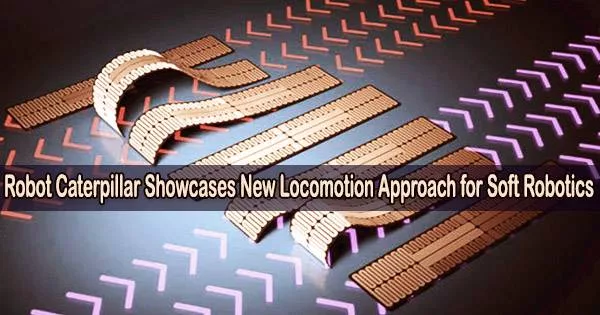North Carolina State University researchers presented a soft robot that moves forward, backward and dips under small gaps. The caterpillar bot moves thanks to a new arrangement of silver nanowires that use heat to control how the robot bends, allowing users to lead it in either direction.
“A caterpillar’s movement is controlled by local curvature of its body its body curves differently when it pulls itself forward than it does when it pushes itself backward,” says Yong Zhu, corresponding author of a paper on the work and the Andrew A. Adams Distinguished Professor of Mechanical and Aerospace Engineering at NC State. “We’ve drawn inspiration from the caterpillar’s biomechanics to mimic that local curvature, and use nanowire heaters to control similar curvature and movement in the caterpillar-bot.”
“Engineering soft robots that can move in two different directions is a significant challenge in soft robotics,” Zhu says. “The embedded nanowire heaters allow us to control the movement of the robot in two ways. We can control which sections of the robot bend by controlling the pattern of heating in the soft robot. And we can control the extent to which those sections bend by controlling the amount of heat being applied.”
The caterpillar-bot is made up of two layers of polymer that react differently when heated. When exposed to heat, the bottom layer shrinks or contracts. When exposed to heat, the top layer expands.
In general, the more current we applied, the faster it would move in either direction. However, we found that there was an optimal cycle, which gave the polymer time to cool effectively allowing the ‘muscle’ to relax before contracting again. If we tried to cycle the caterpillar-bot too quickly, the body did not have time to ‘relax’ before contracting again, which impaired its movement.
Shuang Wu
A pattern of silver nanowires is embedded in the expanding layer of polymer. The pattern includes multiple lead points where researchers can apply an electric current.
By providing an electric current to different lead locations, the researchers can control which areas of the nanowire pattern heat up, as well as the quantity of heat produced by applying more or less current.
“We demonstrated that the caterpillar-bot is capable of pulling itself forward and pushing itself backward,” says Shuang Wu, first author of the paper and a postdoctoral researcher at NC State. “In general, the more current we applied, the faster it would move in either direction. However, we found that there was an optimal cycle, which gave the polymer time to cool effectively allowing the ‘muscle’ to relax before contracting again. If we tried to cycle the caterpillar-bot too quickly, the body did not have time to ‘relax’ before contracting again, which impaired its movement.”
The researchers also proved that the caterpillar bot’s movement could be regulated to the point that users could direct it into a very small gap, much like guiding a robot to pass under a door. In essence, the researchers were able to control the robot’s forward and backward motion, as well as how high it bent upwards at any point during the operation.
“This approach to driving motion in a soft robot is highly energy efficient, and we’re interested in exploring ways that we could make this process even more efficient,” Zhu says. “Additional next steps include integrating this approach to soft robot locomotion with sensors or other technologies for use in various applications such as search-and-rescue devices.”
The work was done with support from the National Science Foundation, under grants 2122841, 2005374, and 2126072; and from the National Institutes of Health, under grant number 1R01HD108473.





